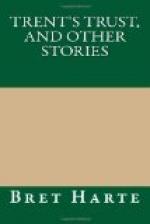The instinct of youthful retaliation to say he knew her address already stirred Randolph, but he shut his lips in time, and moved away. His desk neighbor informed him that the young lady came there once a month and drew a hundred dollars from some deposit to her credit, but that was all they knew. Her name was Caroline Avondale, yet there was no one of that name in the San Francisco Directory.
But Randolph’s romantic curiosity would not allow the incident to rest there. A favorable impression he had produced on Mr. Dingwall enabled him to learn more, and precipitated what seemed to him a singular discovery. “You will find,” said the deputy manager, “the statement of the first deposit to Miss Avondale’s credit in letters in your own department. The account was opened two years ago through a South American banker. But I am afraid it will not satisfy your curiosity.” Nevertheless, Randolph remained after office hours and spent some time in examining the correspondence of two years ago. He was rewarded at last by a banker’s letter from Callao advising the remittance of one thousand dollars to the credit of Miss Avondale of San Francisco. The letter was written in Spanish, of which Randolph had a fair knowledge, but it was made plainer by a space having been left in the formal letter for the English name, which was written in another hand, together with a copy of Miss Avondale’s signature for identification—the usual proceeding in those early days, when personal identification was difficult to travelers, emigrants, and visitors in a land of strangers.
But here he was struck by a singular resemblance which he at first put down to mere coincidence of names. The child’s photograph which he had found in the portmanteau was taken at Callao. That was a mere coincidence, but it suggested to his mind a more singular one—that the handwriting of the address was, in some odd fashion, familiar to him. That night when he went home he opened the portmanteau and took from the purse the scrap of paper with the written address of the bank, and on comparing it with the banker’s letter the next day he was startled to find that the handwriting of the bank’s address and that in which the girl’s name was introduced in the banker’s letter were apparently the same. The letters in the words “Caroline” and “California” appeared as if formed by the same hand. How this might have struck a chirographical expert he did not know. He could not consult the paying teller, who was supposed to be familiar with signatures, without exposing his secret and himself to ridicule. And, after all, what did it prove? Nothing. Even if this girl were cognizant of the man who supplied her address to the Callao banker two years ago, and he was really the missing owner of the portmanteau, would she know where he was now? It might make an opening for conversation if he ever met her familiarly, but nothing more. Yet I am afraid another idea occasionally




